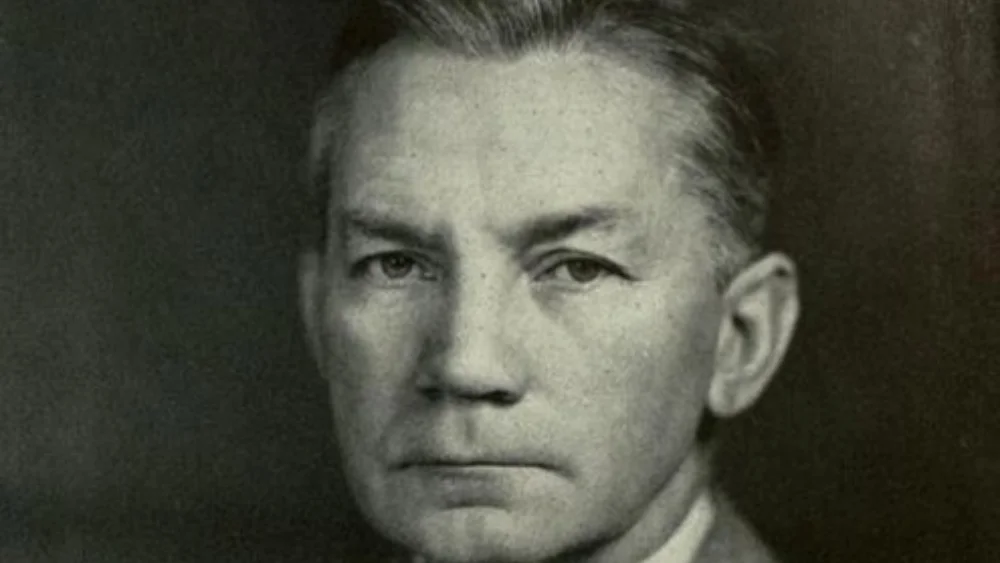James Vincent Forrestal, born on February 15, 1892, in Matteawan, New York, was a distinguished American statesman and the first individual ever to hold the office of United States Secretary of Defense. His tenure in this crucial role, during the turbulent years following World War II, was marked by extraordinary efforts to reorganize and unify the U.S. military establishment. Forrestal’s foresight and dedication led to the creation of the Department of Defense, an achievement that transformed how America prepared for and conducted war in the nuclear age. His contributions to national security, strategic thinking, and organizational reform remain integral to the history of the U.S. military.
Early Life and Education
James Forrestal was born into a working-class Irish Catholic family that faced significant financial challenges. His father, James Forrestal Sr., was an engineer, while his mother, Mary, nurtured their sons with a strong sense of discipline and ambition. Growing up in Beacon, New York, young Forrestal displayed a restless curiosity and an uncommon seriousness. Though his family struggled to make ends meet, Forrestal’s parents emphasized the importance of education as the surest path to a better life.
After excelling academically in local schools, Forrestal set his sights on higher education. He began at Dartmouth College, where he studied with great dedication. While at Dartmouth, he developed an interest in naval affairs and public policy, topics that would come to define his professional life. Although he later transferred to Princeton University, Forrestal left before completing his degree. Instead, he chose to pursue real-world experience in the burgeoning field of finance—a decision that would propel him to prominence on Wall Street.
Despite the unconventional route, Forrestal’s intellectual discipline and relentless drive made him stand out among his peers. His formative years were characterized by quiet confidence and an appetite for learning. These traits would later shape his approach to leadership, strategy, and national service.
A Meteoric Rise on Wall Street
Following his departure from Princeton, Forrestal began his career at William A. Read & Co., an investment banking firm that would eventually become Dillon, Read & Co. His entry into finance coincided with a period of massive economic expansion in the United States. Forrestal distinguished himself with a rare combination of analytical skill, strategic foresight, and calm under pressure. His work ethic and ability to build relationships with powerful clients led to rapid promotion.
By 1923, Forrestal was a partner at Dillon, Read & Co. In a world where fortunes were made and lost overnight, he earned a reputation for sound judgment and integrity. Unlike some of his more flamboyant contemporaries, Forrestal eschewed public attention, preferring instead to focus on results. His understanding of corporate finance, mergers, and the intricacies of capital markets brought him into contact with influential industrialists and policymakers.
During the 1920s and 1930s, Forrestal navigated the economic shocks of the Great Depression with remarkable poise. He became an advocate for thoughtful regulation and long-term investment strategy. His financial career laid the groundwork for the organizational and managerial skills he would later apply to the U.S. Navy and Department of Defense.
In WWII, Forrestal’s public service expanded, with vital U.S. government roles showcasing his dedication to the nation’s cause. He was the Under Secretary of the Navy, overseeing the U.S. Navy’s growth and contributing greatly to the war effort. However, his influence and leadership abilities soon led to his appointment as the Secretary of the Navy by President Franklin D. Roosevelt. In this pivotal role, Forrestal played a crucial part in the expansion and modernization of the U.S. Navy during a time of immense global conflict.
Transition to Public Service
When Franklin D. Roosevelt became president, he began assembling a team of capable administrators to address the nation’s challenges, from economic turmoil to global instability. Forrestal, though a successful financier, felt a growing sense of duty to apply his talents to public service. His reputation for honesty and competence attracted the attention of policymakers seeking leaders who could blend business discipline with government purpose.
In 1940, as war loomed in Europe, President Roosevelt appointed Forrestal as a special assistant to the Under Secretary of the Navy. His financial acumen proved invaluable in overseeing procurement and production. Within a year, he rose to the position of Under Secretary of the Navy, where he helped scale up shipbuilding and logistics to prepare for a conflict that was rapidly engulfing the world.
Secretary of the Navy: Leadership in Wartime
In May 1944, Forrestal succeeded Frank Knox as Secretary of the Navy. The timing could not have been more critical. The United States was fully engaged in a two-front war, with vast naval campaigns across the Atlantic and Pacific. Forrestal’s leadership style combined strategic planning with a commitment to innovation. He championed the development of aircraft carriers, advanced submarines, and more efficient logistical networks. Under his stewardship, the U.S. Navy became the most powerful maritime force in history.
Forrestal emphasized cooperation between military and industrial leaders, believing that America’s technological and manufacturing capacity was key to victory. He tirelessly visited shipyards, naval bases, and front-line units to understand their needs and inspire confidence. Those who served under him often remarked on his personal commitment and unshakable composure in the face of crisis.
Beyond wartime management, Forrestal also considered the long-term implications of naval policy. He believed that America’s security would depend on a sustained investment in sea power, particularly as new geopolitical tensions emerged with the Soviet Union.
James Forrestal and the Cold War Mindset
Forrestal’s leadership did not end with the defeat of Nazi Germany and Imperial Japan. He was one of the earliest U.S. officials to recognize the rising threat of Soviet communism. As tensions between the U.S. and the Soviet Union escalated, Forrestal became a vocal advocate for a strong national defense posture. He saw the need for a united and modern military command to respond to the global geopolitical shift and the beginning of the Cold War.
He viewed containment of Soviet influence as not just a military imperative, but a moral one. In doing so, Forrestal laid the ideological foundation for U.S. defense policy in the Cold War era. His vision of deterrence, readiness, and vigilance guided the U.S. military strategy for decades to come.
Creation of the Department of Defense
After the conclusion of World War II, President Harry S. Truman demonstrated remarkable foresight by acknowledging the necessity of a more organized and cohesive military structure for the United States. In 1947, Truman appointed James Forrestal to the groundbreaking role of the first Secretary of Defense. Forrestal’s exceptional leadership played a pivotal role in shaping the Department of Defense. His visionary approach led to a monumental achievement that forever altered the landscape of American military organization.
Under Forrestal’s guidance, the Department of Defense emerged as a central authority responsible for the coordination and integration of the various branches of the military – the Army, Navy, and Air Force. His ability to navigate complex bureaucratic landscapes and his commitment to efficiency and effectiveness resulted in the establishment of the modern Pentagon.
This momentous development not only streamlined military operations, but also brought greater coordination among the armed forces. It allowed the United States to adapt swiftly and effectively to the challenges of the post-World War II era. The establishment of the Department of Defense marked a turning point in American military organization. James Forrestal’s legacy as its architect remains a powerful testament to his lasting impact on the nation’s defense infrastructure.

Leadership Philosophy and Character
James Forrestal was known for his intense work ethic, intellectual rigor, and personal discipline. Though private and often reserved, he led with strategic foresight and a deep sense of patriotic duty. He believed in empowering leaders within the military while holding them accountable to the nation’s greater interests. His background in finance and business enabled him to apply logic, structure, and innovation to military planning.
Those who worked with him described him as principled and driven, though the burdens he carried often isolated him. He kept personal struggles private, but his commitment to his country and his belief in a strong defense never wavered. His leadership was both a model of effective administration and a cautionary tale of the personal cost of public service.
James Forrestal: Legacy
James Forrestal’s enduring legacy is deeply intertwined with two monumental achievements in American military history. As the first Secretary of Defense, he unified and streamlined the military, a visionary move that reshaped the military structure. Innovative consolidation of military branches in a single department has a lasting impact on U.S. military operations.
Forrestal’s early warning about Soviet intentions, his push for a strong postwar defense strategy, and his creation of a centralized defense apparatus continue to influence U.S. military doctrine. Today, the Department of Defense remains a pillar of national security, thanks in large part to Forrestal’s vision.
Beyond his institutional contributions, Forrestal’s story is a poignant reminder of the human side of leadership. His tragic end catalyzed discussions on mental health, the emotional toll of leadership, and the importance of supporting those who serve not just in combat, but also in public office.
Conclusion
James Vincent Forrestal was a complex figure—part financier, part visionary, and wholly committed to his country’s future. James Forrestal rose from humble beginnings to achieve remarkable success on Wall Street. He went on to play a transformative role in shaping America’s defense strategy during and after World War II. His contributions left a remarkable mark on the nation’s history and established the foundation for modern U.S. defense policy. Though his life ended in tragedy, Forrestal’s legacy underscores the personal sacrifices leaders often make in service to their country.
Forrestal’s contributions continue to offer valuable lessons in strategic leadership as history unfolds. They also serve as powerful reminders of the need for compassion, support, and understanding in the realm of public service.










